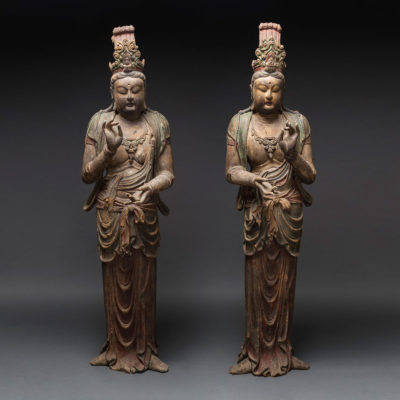 Ancient Art
Ancient Art  Chinese
Chinese  Masterpieces of Chinese Art
Masterpieces of Chinese Art  Pair of Lacquered Wooden Sculptures of Bodhisattvas
Pair of Lacquered Wooden Sculptures of Bodhisattvas
| SKU | LA.559 |
|---|---|
| Circa | 1500 AD to 1800 AD |
| Dimensions | 60″ (152.4cm) high x 14.5″ (36.8cm) wide x 19.5″ (49.5cm) depth |
| Medium | Wood |
| Origin | China |
| Gallery Location | S Korea |
Pair of sculptural standing Avalokitesvara bodhisattvas, the high mukuta crowns, each bejewelled with either a small Amithaba icon, or the sacred bottle, one hand raised in vitarka mudra, the other one softly opened with palm up, the bodies slightly bent in tribanga pose, the bare chests with an ornate necklace, flowing garments reaching the feet and partly covering them. Traces of the original lacquered pigmentation remain.
The confession of the Great Vehicle, Mahayana (chin.: Dasheng), spread from Kashmir, Gandhara, Sogdia and Inner Asia into China, and further to Korea and Japan. It teaches that salvation is possible to all sentient beings because they possess the Buddha nature in them and hence all have the potentiality of being enlightened. Enlightenment is simply achieved by faith and devotion to Buddha and the religious ideal, the Bodhisattva (chin.: Pusa), Pratyekabuddha (chin.: Pizhifo) or Arhat (chin.: Aluohan, short: Luohan). These beings, though qualified to enter nirvana, delay their final entry in order to bring every sentient being across the sea of misery to the calm shores of enlightenment.
Avalokitesvara (“Observing the Sounds of the World”, chin.: Guanshiyin, short: Guanyin, or Guanzizai), the Bodhisattva of Compassion, is one of the most venerated icon of the Buddhist Pantheon. In this case, the two mirror images would have been placed to the side of the main Buddha as his flanking attendants, in the main temple hall.
Login to view price
Sign-up to receive the latest Wedding Estates news and promotions!

